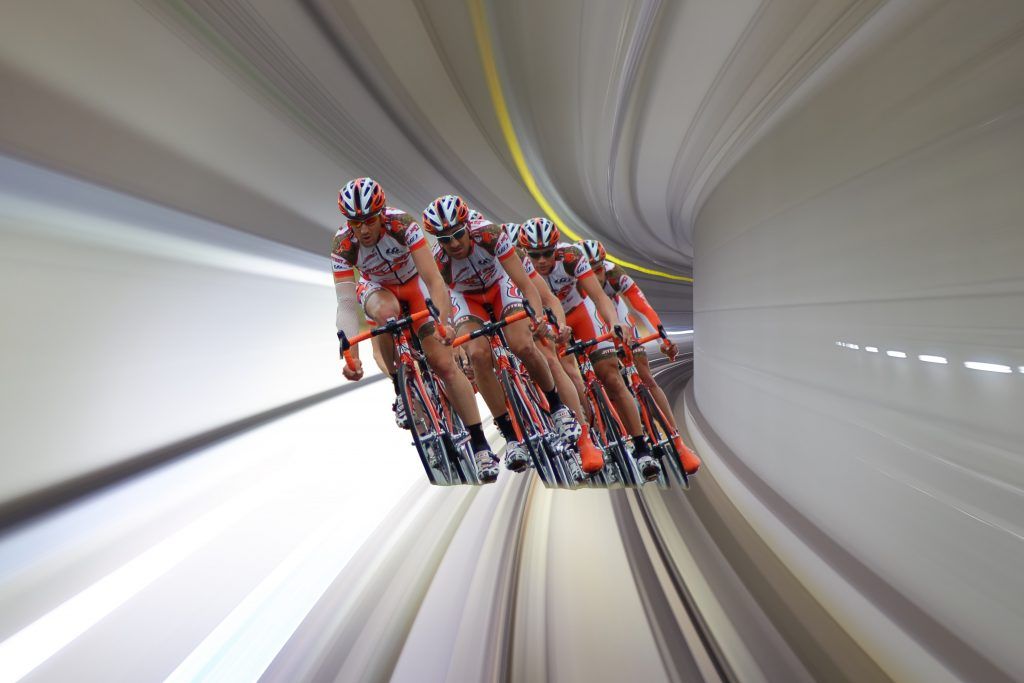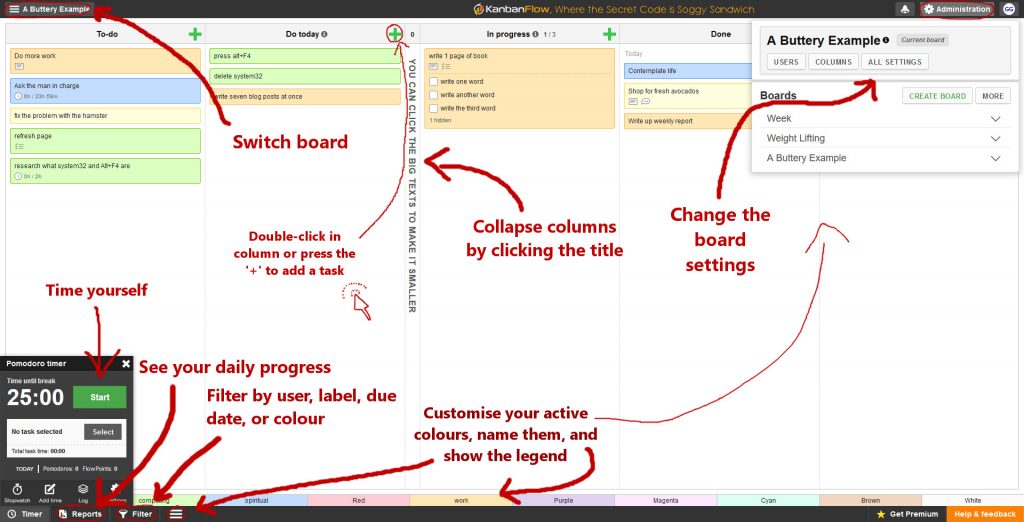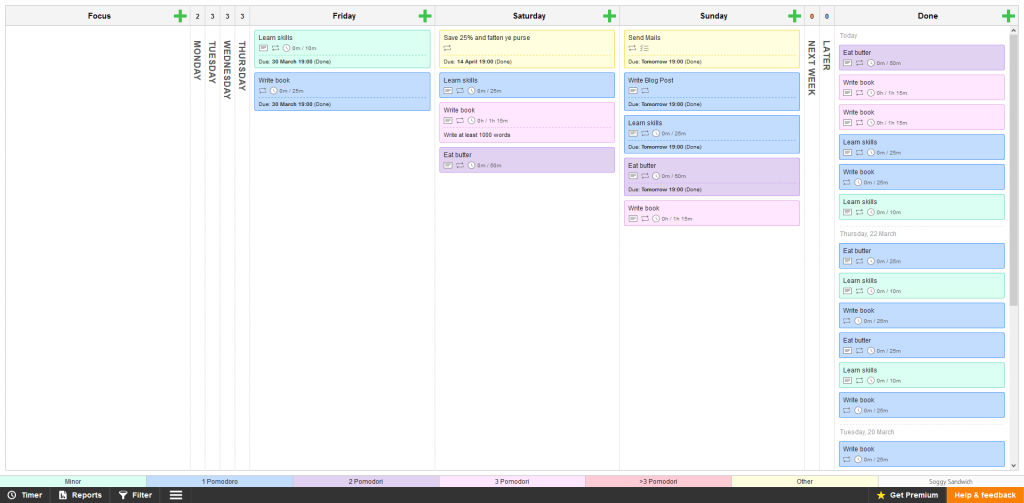Update: This post now has a free complementary video with details of setting up your weekly-planner-style KanbanFlow board!
insert_linkHow Organised is Your Life?

There should be no surprises when I say organisation is key when talking about how to be productive.
Despite many people accepting this statement to be true, some of us don’t act accordingly. Consequently, you’ll find an overabundance of disorganised people who simply don’t know how to be productive. Some people, however, are fine with a mediocre lifestyle, whilst others (like you, I assume) have wishful goals that they want to meet.
The problem we find is that, even though the desire to achieve remarkable things is present, there is a lack of motivation driving people through the necessary process—the path that leads to results. We mere mortals cower beneath the heavy, intimidating, ever-accumulating pile of work. Funny, why is this so if we know we must work to get results?
Admittedly, there is a tremendous deal of factors that contribute to a productive workflow. In this article, we will only be investigating a few of said factors, regardless of their equal importance. Still, you will be able to begin the transformation of your life with today’s article; after all, the best path is the one on which you take one step at a time.
insert_linkDo You Know How to Be Productive?
If you’ve come here to get a noticeable boost in your productivity, I predict you aren’t as organised as can be. This is primarily true assuming you’re only getting started on the road to unparalleled success.
How is your life organised? Glance at everything you do and try to discern any systems you employ. Perhaps, some things are nicely organised, and you didn’t even know it.
Flipping over to the other side of things, how much of your life can be organised for the better? To exemplify, you might think of having a list of tasks that you will work on specifically. Moreover, you might want to manage the amount of time spent wasted, increasing productive time.
No matter who you are, or what you do, benefits come from organisation; albeit this is especially true if you have an irritatingly busy life.
insert_linkWhy Organise My Life?

Don’t say, “I can’t be bothered,” since that attitude is a guaranteed ticket for tonight’s failure concert. Rather, I guarantee you that your initial investment in willpower to get a grip on your life will change you: less of you saying, “I can’t be bothered,” that is to say.
Indeed, I am at liberty to write an article on resilience, persistence, mental toughness, or any of that good stuff. So, why don’t I? Why do I choose to focus specifically on organisation? Is it really as critical as any of the aforementioned qualities of an outstandingly productive idol?
Yes, it is. In my opinion, organisation—having set systems for what you do—is the absolute basis for productivity. Dare I say, one of the productivity gods.
Luckily, organisation is one of the easier strategies for you to get started with: all it requires is some quality time, with a quill and some parchment, allocated to planning.
Moreover, it is very effective, reducing the volume of effort you must exert when working. It makes your life, easier, in other words—and you will feel that newfound ease within your blood vessels.
Sometimes people undervalue the power of organisation, hence neglecting it. Little do those people realise that organisation can skyrocket your results, additionally taking the stress out of your life, improving your mental wellbeing. Who doesn’t relish the satisfaction of a productive day full of wonderful work?
insert_linkDefeat Procrastination and Get Things Done

There are, contrary to the belief of the masses, profound benefits of procrastinating, as I recently found out in this book. However, this is not the reason that people procrastinate, achieving nothing much with their lives. To illustrate, let us investigate some causes of—and solutions to—procrastination.
insert_linkIntense Workloads
Firstly, a cumbersome list of tasks on your to-do list probably scares you out of doing any of it. You see the immense workload that must be tackled, and such you are more likely to procrastinate; playing minesweeper on your Windows 95 device seems like an easier, more enjoyable use of your time.
Don’t get into that position. Instead, if plan your workflow by splitting the load into small, manageable chunks, you are more likely to actually get the work done. There is also another effect when telling yourself to work on a small step at a time: you get ‘in da groove,’ which is the state where it is easier to do more than the prescribed amount of work.
insert_linkIndecisiveness
Secondly, we may be inclined to procrastinate because we do not know what to do next. For example, you don’t quite know exactly where to begin, with your list of 71 tasks. And as you know, indecisiveness leads to terminal procrastination.

As a result of having a clearly laid out plan of what you are going to do and when, everything seems to be easier. For instance, you don’t need to decide, or formulate an idea for, what you need to do next.
insert_linkCommitment
Thirdly, yet another factor of procrastination is the absence of urgency and commitment. Even though you might delay completing a task, you could eventually end up doing everything that had a deadline attached to it, or of which its incompletion threatens your life, financial situation, or something else you value.
Fortunately, you can use those angry motivators to your advantage. In order to ensure you get your tasks done timely, you must commit yourself to the work. As an example, you could promise yourself that you will complete a task at a certain time, regardless of how you will feel.
In fact, make it (mentally) a matter of life and death; I guarantee that you will be motivated to get working.
insert_linkStop Wasting Time
As discussed above, one can avoid wasting time by procrastinating and being indecisive. Furthermore, on my comment of indecisiveness, it is worth mentioning that this is an interesting way of losing time.
To explain, you could end up reduced to lying on the sofa, deliberating and dreading, deciding what to do: do you work on this task? How about that one—perhaps it is easier? No! It is less important. You can’t just play minesweeper all day… what do you do?

Being organised, hence knowing exactly what to do, eliminates this unproductive time completely.
Additionally, organisation enables you to do things you wouldn’t have otherwise done. Therefore, you spend more time being productive as opposed to playing minesweeper. You could, if you’re really strategic, only allow yourself to rest (play minesweeper) once you have done a pre-determined amount of work.
A further reason organisation saves time is that it can make you work faster. In other words, get the same work done in a shorter space of time compared to your unknowledgeable, identical twin in the second dimension. Of course, this applies exclusively if you know ‘the ways,’ which we will discuss later.
insert_linkRelax
Ironically, knowing how to be productive by getting yourself organised can make your life more relaxed. I’ve already briefly tapped on this earlier; it is less stressful when you are able to get your work done consistently and timely.
You can relax knowing you are getting your work done properly, rather than looming in the ‘dark playground’ of guilt and dread. Although the process of working may not be entirely enjoyable, it is worth the pain; in exchange, you get a life where you are not constantly worrying about those intimidating to-dos.
Also, time for relaxation is infinitely better when it acts as a reward for difficult, exhausting work. In this situation, the reward of relaxation motivates you to be productive and get working.
insert_linkIncrease Your Productivity—Boost Your Successes
I’ve gotten this far, and I haven’t even mentioned how you can achieve all of the above. I can go on about organisation all day, but it’s no use if you don’t know how to get organised easily. In response to this, I shall share with you a tool I use that is the answer to how to be productive: KanbanFlow.
Okay, Mr Butter Man, what is this productivity tool?
KanbanFlow is a website allowing you to manage your tasks as cards in columns on a board, put simply. The default columns when you create a new board are ‘To-do,’ ‘Do today,’ ‘In progress,’ and ‘Done.’ Clearly, you are supposed to have a list of to-dos that you shuffle to the next column as appropriate. This is much like a production line, as the word Kanban suggests.
Despite this method enabling you to focus on your tasks, I don’t believe it is how to be productive. Inevitably, I have other ideas for this service, which you can enjoy later.
insert_linkWhy KanbanFlow Over Other Productivity/Kanban Boards?
You may, in fact, know about alternative boards or productivity tools such as Trello, for example. While I do use Trello for making basic lists and managing certain things, KanbanFlow stands out for productively getting stuff done.

To begin with, it has a built-in Pomodoro® timer, which employs the Pomodoro Technique® to increases your productivity so you get work done faster for longer. This is far better than buying a tomato-shaped (‘pomodoro’ is ‘tomato’ in Italian) cooking timer.
The “Pomodoro Technique®” and “Pomodoro®” are registered trademarks by Francesco Cirillo.
Utilising timer integration, you can track how much time you are spending working on each task. Moreover, you can monitor how many Pomodoros you achieve each day and any interruptions to your workflow. Alternatively, you can use a stopwatch, though I don’t see a productive use for that.
With this in mind, you are able to detect flaws in your productivity plan, so you can enhance it. For example, you might consider locking yourself in a shed where nobody can disturb you if interruptions are a problem.
In addition, another appreciable feature of KanbanFlow that I love is deadlines. That is to say, you are able to tell tasks that they have to be in a certain column (e.g. ‘Done’) by a certain time and date. This is convenient, primarily to motivate you to work faster and keep track of when you need to do things.
If that wasn’t enough, however, you can also create repeating tasks. Say, for instance, you want to consistently produce a book each week, you could make a repeating task for that. As a result, when you move the column to its target column, it will automatically reappear in the starting column, this time due for the next week.
insert_linkOther Features Making Productivity Easy
- Colourising each card with a customisable set of colours, complete with a colour legend.
- Giving cards label(s) so you can better organise your tasks.
- Subtasks which help you break down your tasks and further track their progress.
- Inviting people to use your board.
- A filter to focus on specific cards based on user, colour, due date, and/or label.
- Collapsing columns in order to focus on important, relevant ones.
- Sound and the timer shown in the website title, so you’ll never miss a completed Pomodoro®.
- Customisable notifications, through email and on the website.
- Customisation of how columns show tasks (labels, descriptions, subtasks, due dates, archiving etc.)
- A plethora of more features with the premium version, including a calendar and swimlanes.
insert_linkHow to Be Productive Times Ten
insert_linkColumns
Like I said earlier, I don’t believe an ‘In progress column’ and a generic to-do lists suffices the needs of a productivity ninja. In fact, I prefer to plan my entire week using KanbanFlow (credit to John Sonmez and his book Soft Skills). This entails creating a column for each day of the week, perhaps Next week and Later too, a Today column, and a Done column.

This week layout gives you further control as to when you are doing tasks, for easier distribution across the week. Also, this can be especially useful for organising repeating tasks for certain days of the week.
The Today column is the one to which you move tasks associated with the current day. For example, on a Monday, move the cards form that column to today, to provide a focus for what you need to do. You can also put tasks here that you haven’t planned beforehand, and that need to get done ASAP.
The Done column should go at the end of the board, so tasks with due dates can use it. Otherwise, not all tasks can set to be due for the Done column; you can only set the destination column as one to the right of the origin column.
I recommend ordering the tasks in your Today column, so it reflects priority and order in which they are to be completed. You may also want to consider showing descriptions and subtasks for that one.
insert_linkColours
Categorising your tasks by colour can be a terrific way to organise your work. To illustrate, it can make it easier to distribute your tasks across the week for a balanced dosage of work.
Like my last recommendation, I have yet another tip I have acquired from John Sonmez from SimpleProgrammer.com. This is to colour each task based on its estimated required Pomodori. To clarify, you will have each colour associated with a number of Pomodori.
The reason you would do this is to easier plan your tasks according to its estimated time, so you don’t end up overworking one day and underworking another. For each task, in general, it may be wise to rarely go beyond three Pomodori per task.
insert_linkMulti-Purpose
In addition to your primary work board, you could have other organisational boards. A timetable is an example of how you can reap the benefits of KanbanFlow’s flexibility. Colours and labels add the seasoning and spice—no artificial preservatives.
This illustrates how KanbanFlow can be used for more than managing your work; it can be used to plan routines and make lists. Furthermore, you can use it to track the progress of long-term activities such as planning social media posts.
If you were to use a board as a list, it is easy to rearrange items within them, moving them about as you please. While I cannot enumerate all potential uses for boards, you can get creative knowing what will benefit you.

insert_linkWhat to do now
If you’re interested in achieving ultimate productivity, check out some books like The War of Art, The 7 Habits of Highly Effective People, and Soft Skills, which has a section about productivity mentioning KanbanFlow and The Pomodoro Technique®.
To complement your KanbanFlow boards, you may use Workflowy to organise your brain. I don’t know about you, but I love to bullet-point bullet-points in lists. As well as that, you should brainstorm your ideas with an online MindMeister mind-map.
Also, subscribe via email to hear about new posts or follow me on social media below.
This blog, Cryptic Butter, is not affiliated with, associated with, or endorsed by the Pomodoro Technique® or Francesco Cirillo.


